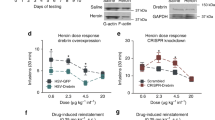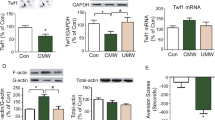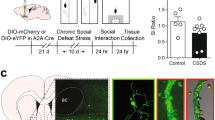Abstract
The nucleus accumbens (NAc) is a primary brain reward region composed predominantly of medium spiny neurons (MSNs). In response to early withdrawal from repeated cocaine administration, de novo dendritic spine formation occurs in NAc MSNs. Much evidence indicates that this new spine formation facilitates the rewarding properties of cocaine. Early withdrawal from repeated cocaine also produces dramatic alterations in the transcriptome of NAc MSNs, but how such alterations influence cocaine’s effects on dendritic spine formation remain unclear. Studies in non-neuronal cells indicate that actin cytoskeletal regulatory pathways in nuclei have a direct role in the regulation of gene transcription in part by controlling the access of co-activators to their transcription factor partners. In particular, actin state dictates the interaction between the serum response factor (SRF) transcription factor and one of its principal co-activators, MAL. Here we show that cocaine induces alterations in nuclear F-actin signaling pathways in the NAc with associated changes in the nuclear subcellular localization of SRF and MAL. Using in vivo optogenetics, the brain region-specific inputs to the NAc that mediate these nuclear changes are investigated. Finally, we demonstrate that regulated SRF expression, in turn, is critical for the effects of cocaine on dendritic spine formation and for cocaine-mediated behavioral sensitization. Collectively, these findings reveal a mechanism by which nuclear-based changes influence the structure of NAc MSNs in response to cocaine.
This is a preview of subscription content, access via your institution
Access options
Subscribe to this journal
Receive 12 print issues and online access
$259.00 per year
only $21.58 per issue
Buy this article
- Purchase on Springer Link
- Instant access to full article PDF
Prices may be subject to local taxes which are calculated during checkout





Similar content being viewed by others
References
Penzes P, Cahill ME, Jones KA, VanLeeuwen JE, Woolfrey KM . Dendritic spine pathology in neuropsychiatric disorders. Nat Neurosci 2011; 14: 285–293.
Penzes P, Cahill ME . Deconstructing signal transduction pathways that regulate the actin cytoskeleton in dendritic spines. Cytoskeleton (Hoboken) 2012; 69: 426–441.
Matsuzaki M, Ellis-Davies GC, Nemoto T, Miyashita Y, Iino M, Kasai H . Dendritic spine geometry is critical for AMPA receptor expression in hippocampal CA1 pyramidal neurons. Nat Neurosci 2001; 4: 1086–1092.
Robinson TE, Gorny G, Mitton E, Kolb B . Cocaine self-administration alters the morphology of dendrites and dendritic spines in the nucleus accumbens and neocortex. Synapse 2001; 39: 257–266.
Pulipparacharuvil S, Renthal W, Hale CF, Taniguchi M, Xiao G, Kumar A et al. Cocaine regulates MEF2 to control synaptic and behavioral plasticity. Neuron 2008; 59: 621–633.
Dietz DM, Sun H, Lobo MK, Cahill ME, Chadwick B, Gao V et al. Rac1 is essential in cocaine-induced structural plasticity of nucleus accumbens neurons. Nat Neurosci 2012; 15: 891–896.
Shen HW, Toda S, Moussawi K, Bouknight A, Zahm DS, Kalivas PW . Altered dendritic spine plasticity in cocaine-withdrawn rats. J Neurosci 2009; 29: 2876–2884.
Graziane NM, Sun S, Wright WJ, Jang D, Liu Z, Huang YH et al. Opposing mechanisms mediate morphine- and cocaine-induced generation of silent synapses. Nat Neurosci 2016; 19: 915–925.
Dong Y, Nestler EJ . The neural rejuvenation hypothesis of cocaine addiction. Trends Pharmacol Sci 2014; 35: 374–383.
Golden SA, Russo SJ . Mechanisms of psychostimulant-induced structural plasticity. Cold Spring Harb Perspect Med 2012; 2.
Russo SJ, Dietz DM, Dumitriu D, Morrison JH, Malenka RC, Nestler EJ . The addicted synapse: mechanisms of synaptic and structural plasticity in nucleus accumbens. Trends Neurosci 2010; 33: 267–276.
Stankeviciute NM, Scofield MD, Kalivas PW, Gipson CD . Rapid, transient potentiation of dendritic spines in context-induced relapse to cocaine seeking. Addict Biol 2014; 19: 972–974.
Smith AC, Kupchik YM, Scofield MD, Gipson CD, Wiggins A, Thomas CA et al. Synaptic plasticity mediating cocaine relapse requires matrix metalloproteinases. Nat Neurosci 2014; 17: 1655–1657.
Lee BR, Ma YY, Huang YH, Wang X, Otaka M, Ishikawa M et al. Maturation of silent synapses in amygdala-accumbens projection contributes to incubation of cocaine craving. Nat Neurosci 2013; 16: 1644–1651.
Ma YY, Lee BR, Wang X, Guo C, Liu L, Cui R et al. Bidirectional modulation of incubation of cocaine craving by silent synapse-based remodeling of prefrontal cortex to accumbens projections. Neuron 2014; 83: 1453–1467.
Brown TE, Lee BR, Mu P, Ferguson D, Dietz D, Ohnishi YN et al. A silent synapse-based mechanism for cocaine-induced locomotor sensitization. J Neurosci 2011; 31: 8163–8174.
Wang X, Cahill ME, Werner CT, Christoffel DJ, Golden SA, Xie Z et al. Kalirin-7 mediates cocaine-induced AMPA receptor and spine plasticity, enabling incentive sensitization. J Neurosci 2013; 33: 11012–11022.
Pascoli V, Turiault M, Luscher C . Reversal of cocaine-evoked synaptic potentiation resets drug-induced adaptive behaviour. Nature 2012; 481: 71–75.
Gipson CD, Kupchik YM, Shen H, Reissner KJ, Thomas CA, Kalivas PW . Relapse induced by cues predicting cocaine depends on rapid, transient synaptic potentiation. Neuron 2013; 77: 867–872.
Robison AJ, Nestler EJ . Transcriptional and epigenetic mechanisms of addiction. Nat Rev Neurosci 2011; 12: 623–637.
Magill ST, Cambronne XA, Luikart BW, Lioy DT, Leighton BH, Westbrook GL et al. microRNA-132 regulates dendritic growth and arborization of newborn neurons in the adult hippocampus. Proc Natl Acad Sci USA 2010; 107: 20382–20387.
Ramanan N, Shen Y, Sarsfield S, Lemberger T, Schutz G, Linden DJ et al. SRF mediates activity-induced gene expression and synaptic plasticity but not neuronal viability. Nat Neurosci 2005; 8: 759–767.
Cahill ME, Bagot RC, Gancarz AM, Walker DM, Sun H, Wang ZJ et al. Bidirectional synaptic structural plasticity after chronic cocaine administration occurs through Rap1 small GTPase signaling. Neuron 2016; 89: 566–582.
Sukumvanich P, DesMarais V, Sarmiento CV, Wang Y, Ichetovkin I, Mouneimne G et al. Cellular localization of activated N-WASP using a conformation-sensitive antibody. Cell Motil Cytoskeleton 2004; 59: 141–152.
Golden SA, Christoffel DJ, Heshmati M, Hodes GE, Magida J, Davis K et al. Epigenetic regulation of RAC1 induces synaptic remodeling in stress disorders and depression. Nat Med 2013; 19: 337–344.
Hollander JA, Im HI, Amelio AL, Kocerha J, Bali P, Lu Q et al. Striatal microRNA controls cocaine intake through CREB signalling. Nature 2010; 466: 197–202.
Impey S, Davare M, Lesiak A, Fortin D, Ando H, Varlamova O et al. An activity-induced microRNA controls dendritic spine formation by regulating Rac1-PAK signaling. Mol Cell Neurosci 2010; 43: 146–156.
Ye J, Zhao J, Hoffmann-Rohrer U, Grummt I . Nuclear myosin I acts in concert with polymeric actin to drive RNA polymerase I transcription. Genes Dev 2008; 22: 322–330.
Wu X, Yoo Y, Okuhama NN, Tucker PW, Liu G, Guan JL . Regulation of RNA-polymerase-II-dependent transcription by N-WASP and its nuclear-binding partners. Nat Cell Biol 2006; 8: 756–763.
Grosse R, Vartiainen MK . To be or not to be assembled: progressing into nuclear actin filaments. Nat Rev Mol Cell Biol 2013; 14: 693–697.
Vartiainen MK . Nuclear actin dynamics—from form to function. FEBS Lett 2008; 582: 2033–2040.
Banerjee J, Fischer CC, Wedegaertner PB . The amino acid motif L/IIxxFE defines a novel actin-binding sequence in PDZ-RhoGEF. Biochemistry 2009; 48: 8032–8043.
Koskinen M, Hotulainen P . Measuring F-actin properties in dendritic spines. Front Neuroanat 2014; 8: 74.
Posern G, Treisman R . Actin' together: serum response factor, its cofactors and the link to signal transduction. Trends Cell Biol 2006; 16: 588–596.
Vartiainen MK, Guettler S, Larijani B, Treisman R . Nuclear actin regulates dynamic subcellular localization and activity of the SRF cofactor MAL. Science 2007; 316: 1749–1752.
Guettler S, Vartiainen MK, Miralles F, Larijani B, Treisman R . RPEL motifs link the serum response factor cofactor MAL but not myocardin to Rho signaling via actin binding. Mol Cell Biol 2008; 28: 732–742.
Kokai E, Beck H, Weissbach J, Arnold F, Sinske D, Sebert U et al. Analysis of nuclear actin by overexpression of wild-type and actin mutant proteins. Histochem Cell Biol 2014; 141: 123–135.
Stern S, Debre E, Stritt C, Berger J, Posern G, Knoll B . A nuclear actin function regulates neuronal motility by serum response factor-dependent gene transcription. J Neurosci 2009; 29: 4512–4518.
Posern G, Miralles F, Guettler S, Treisman R . Mutant actins that stabilise F-actin use distinct mechanisms to activate the SRF coactivator MAL. EMBO J 2004; 23: 3973–3983.
Baarlink C, Wang H, Grosse R . Nuclear actin network assembly by formins regulates the SRF coactivator MAL. Science 2013; 340: 864–867.
Muehlich S, Hermanns C, Meier MA, Kircher P, Gudermann T . Unravelling a new mechanism linking actin polymerization and gene transcription. Nucleus 2016; 7: 121–125.
Medina F, Carter AM, Dada O, Gutowski S, Hadas J, Chen Z et al. Activated RhoA is a positive feedback regulator of the Lbc family of Rho guanine nucleotide exchange factor proteins. J Biol Chem 2013; 288: 11325–11333.
Liu HW, Halayko AJ, Fernandes DJ, Harmon GS, McCauley JA, Kocieniewski P et al. The RhoA/Rho kinase pathway regulates nuclear localization of serum response factor. Am J Respir Cell Mol Biol 2003; 29: 39–47.
Vialou V, Maze I, Renthal W, LaPlant QC, Watts EL, Mouzon E et al. Serum response factor promotes resilience to chronic social stress through the induction of DeltaFosB. J Neurosci 2010; 30: 14585–14592.
Deroche-Gamonet V, Belin D, Piazza PV . Evidence for addiction-like behavior in the rat. Science 2004; 305: 1014–1017.
Bossert JM, Ghitza UE, Lu L, Epstein DH, Shaham Y . Neurobiology of relapse to heroin and cocaine seeking: an update and clinical implications. Eur J Pharmacol 2005; 526: 36–50.
Conrad KL, Tseng KY, Uejima JL, Reimers JM, Heng LJ, Shaham Y et al. Formation of accumbens GluR2-lacking AMPA receptors mediates incubation of cocaine craving. Nature 2008; 454: 118–121.
White SL, Ortinski PI, Friedman SH, Zhang L, Neve RL, Kalb RG et al. A critical role for the GluA1 accessory protein, SAP97, in cocaine seeking. Neuropsychopharmacology 2016; 41: 736–750.
Kalivas PW . The glutamate homeostasis hypothesis of addiction. Nat Rev Neurosci 2009; 10: 561–572.
Reissner KJ, Gipson CD, Tran PK, Knackstedt LA, Scofield MD, Kalivas PW . Glutamate transporter GLT-1 mediates N-acetylcysteine inhibition of cocaine reinstatement. Addict Biol 2015; 20: 316–323.
Doyle SE, Ramoa C, Garber G, Newman J, Toor Z, Lynch WJ . A shift in the role of glutamatergic signaling in the nucleus accumbens core with the development of an addicted phenotype. Biol Psychiatry 2014; 76: 810–815.
Loweth JA, Tseng KY, Wolf ME . Adaptations in AMPA receptor transmission in the nucleus accumbens contributing to incubation of cocaine craving. Neuropharmacology 2014; 76 (Pt B): 287–300.
Schmidt HD, Pierce RC . Cocaine-induced neuroadaptations in glutamate transmission: potential therapeutic targets for craving and addiction. Ann N Y Acad Sci 2010; 1187: 35–75.
Phillipson OT, Griffiths AC . The topographic order of inputs to nucleus accumbens in the rat. Neuroscience 1985; 16: 275–296.
Friedman DP, Aggleton JP, Saunders RC . Comparison of hippocampal, amygdala, and perirhinal projections to the nucleus accumbens: combined anterograde and retrograde tracing study in the Macaque brain. J Comp Neurol 2002; 450: 345–365.
Britt JP, Benaliouad F, McDevitt RA, Stuber GD, Wise RA, Bonci A . Synaptic and behavioral profile of multiple glutamatergic inputs to the nucleus accumbens. Neuron 2012; 76: 790–803.
Pascoli V, Terrier J, Espallergues J, Valjent E, O'Connor EC, Luscher C . Contrasting forms of cocaine-evoked plasticity control components of relapse. Nature 2014; 509: 459–464.
Stefanik MT, Moussawi K, Kupchik YM, Smith KC, Miller RL, Huff ML et al. Optogenetic inhibition of cocaine seeking in rats. Addict Biol 2013; 18: 50–53.
Stefanik MT, Kalivas PW . Optogenetic dissection of basolateral amygdala projections during cue-induced reinstatement of cocaine seeking. Front Behav Neurosci 2013; 7: 213.
Stefanik MT, Kupchik YM, Kalivas PW . Optogenetic inhibition of cortical afferents in the nucleus accumbens simultaneously prevents cue-induced transient synaptic potentiation and cocaine-seeking behavior. Brain Struct Funct 2016; 221: 1681–1689.
Kawashima T, Okuno H, Nonaka M, Adachi-Morishima A, Kyo N, Okamura M et al. Synaptic activity-responsive element in the Arc/Arg3.1 promoter essential for synapse-to-nucleus signaling in activated neurons. Proc Natl Acad Sci USA 2009; 106: 316–321.
Nimchinsky EA, Sabatini BL, Svoboda K . Structure and function of dendritic spines. Annu Rev Physiol 2002; 64: 313–353.
Peebles CL, Yoo J, Thwin MT, Palop JJ, Noebels JL, Finkbeiner S . Arc regulates spine morphology and maintains network stability in vivo. Proc Natl Acad Sci USA 2010; 107: 18173–18178.
Li Y, Acerbo MJ, Robinson TE . The induction of behavioural sensitization is associated with cocaine-induced structural plasticity in the core (but not shell) of the nucleus accumbens. Eur J Neurosci 2004; 20: 1647–1654.
Vialou V, Feng J, Robison AJ, Ku SM, Ferguson D, Scobie KN et al. Serum response factor and cAMP response element binding protein are both required for cocaine induction of DeltaFosB. J Neurosci 2012; 32: 7577–7584.
Lu L, Grimm JW, Dempsey J, Shaham Y . Cocaine seeking over extended withdrawal periods in rats: different time courses of responding induced by cocaine cues versus cocaine priming over the first 6 months. Psychopharmacology (Berl) 2004; 176: 101–108.
Grimm JW, Hope BT, Wise RA, Shaham Y . Neuroadaptation. Incubation of cocaine craving after withdrawal. Nature 2001; 412: 141–142.
MacAskill AF, Cassel JM, Carter AG . Cocaine exposure reorganizes cell type- and input-specific connectivity in the nucleus accumbens. Nat Neurosci 2014; 17: 1198–1207.
Ambroggi F, Ishikawa A, Fields HL, Nicola SM . Basolateral amygdala neurons facilitate reward-seeking behavior by exciting nucleus accumbens neurons. Neuron 2008; 59: 648–661.
Suska A, Lee BR, Huang YH, Dong Y, Schluter OM . Selective presynaptic enhancement of the prefrontal cortex to nucleus accumbens pathway by cocaine. Proc Natl Acad Sci USA 2013; 110: 713–718.
Koya E, Cruz FC, Ator R, Golden SA, Hoffman AF, Lupica CR et al. Silent synapses in selectively activated nucleus accumbens neurons following cocaine sensitization. Nat Neurosci 2012; 15: 1556–1562.
Lee BR, Dong Y . Cocaine-induced metaplasticity in the nucleus accumbens: silent synapse and beyond. Neuropharmacology 2011; 61: 1060–1069.
Toda S, Shen HW, Peters J, Cagle S, Kalivas PW . Cocaine increases actin cycling: effects in the reinstatement model of drug seeking. J Neurosci 2006; 26: 1579–1587.
Toda S, Shen H, Kalivas PW . Inhibition of actin polymerization prevents cocaine-induced changes in spine morphology in the nucleus accumbens. Neurotox Res 2010; 18: 410–415.
Acknowledgements
This work was supported by NIH grants P01DA008227 (EJN), R01DA014133 (EJN) and R01DA037257 (DMD). We thank John Condeelis of the Albert Einstein College of Medicine for the active N-WASP antibody.
Author contributions
MEC and EJN conceived the study and wrote the manuscript. MEC, DMW, AMG, ZJW, CKL, RCB and DMD generated data. RLN designed essential constructs specifically for the experiments in this study.
Author information
Authors and Affiliations
Corresponding author
Ethics declarations
Competing interests
The authors declare no conflict of interest.
Additional information
Supplementary Information accompanies the paper on the Molecular Psychiatry website
Supplementary information
Rights and permissions
About this article
Cite this article
Cahill, M., Walker, D., Gancarz, A. et al. The dendritic spine morphogenic effects of repeated cocaine use occur through the regulation of serum response factor signaling. Mol Psychiatry 23, 1474–1486 (2018). https://doi.org/10.1038/mp.2017.116
Received:
Revised:
Accepted:
Published:
Issue Date:
DOI: https://doi.org/10.1038/mp.2017.116
This article is cited by
-
Genetics of amyotrophic lateral sclerosis: seeking therapeutic targets in the era of gene therapy
Journal of Human Genetics (2023)
-
SRF in Neurochemistry: Overview of Recent Advances in Research on the Nervous System
Neurochemical Research (2022)
-
Cocaine-induced neuron subtype mitochondrial dynamics through Egr3 transcriptional regulation
Molecular Brain (2021)
-
Serum- and glucocorticoid-inducible kinase 1 activity in ventral tegmental area dopamine neurons regulates cocaine conditioned place preference but not cocaine self-administration
Neuropsychopharmacology (2021)
-
The Rap1 small GTPase is a critical mediator of the effects of stress on prefrontal cortical dysfunction
Molecular Psychiatry (2021)



